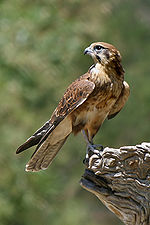The Piacenzian is in the international geologic time scale the upper stage or latest age of the Pliocene. It spans the time between 3.6 ± 0.005 Ma and...
13 KB (1,354 words) - 15:15, 13 December 2024
The Mid-Piacenzian Warm Period (mPWP) (prior to 2009 known as the Middle Pliocene Warm Period ), or the Pliocene Thermal Maximum, was an interval of warm...
22 KB (2,347 words) - 23:45, 18 November 2024
preceded by the Messinian Age of the Miocene Epoch, and followed by the Piacenzian Age. The Zanclean can be correlated with regionally used stages, such...
9 KB (830 words) - 11:29, 19 December 2024
1967 (Piacenzian to the Gelasian stages of western United States and Mexico) Genus Podiceps Latham 1787 †Podiceps arndti Chandler, 1990 (Piacenzian stage...
42 KB (3,619 words) - 01:17, 2 November 2024
stages. From youngest to oldest they are: Piacenzian (3.60–2.58 Ma) Zanclean (5.33–3.60 Ma) The Piacenzian is sometimes referred to as the Late Pliocene...
58 KB (6,256 words) - 15:18, 13 December 2024
is an extinct species of Ardenna that lived in New Zealand during the Piacenzian stage. Tennyson, Alan J. D.; Salvador, Rodrigo B.; Tomotani, Barbara M...
1 KB (65 words) - 10:39, 5 January 2025
an extinct species of Eudyptula that lived in New Zealand during the Piacenzian stage. Thomas, Daniel B.; Tennyson, Alan J. D.; Marx, Felix G.; Ksepka...
1 KB (67 words) - 18:41, 21 December 2024
time between 2.58 Ma (million years ago) and 1.80 Ma. It follows the Piacenzian Stage (part of the Pliocene) and is followed by the Calabrian Stage. The...
8 KB (628 words) - 14:47, 13 December 2024
and most yellow-bellied forms, all of which took place during the late Piacenzian (early Late Pliocene), c. 3 mya. Three species are poly- or paraphyletic...
12 KB (953 words) - 22:57, 21 August 2024
recent) to lower (earlier): The Pliocene Epoch is subdivided into two ages: Piacenzian Age, preceded by Zanclean Age The Miocene Epoch is subdivided into six...
25 KB (2,657 words) - 21:38, 21 December 2024
Spotted hyena (category Extant Piacenzian first appearances)
This article contains Ethiopic text. Without proper rendering support, you may see question marks, boxes, or other symbols instead of Ethiopic characters...
120 KB (14,129 words) - 12:40, 9 January 2025
confidently placed from the Miocene-Pliocene boundary through the Zanclean and Piacenzian and just into the Gelasian, that is from 2.4 to 5.3 Mya, when the malar-striped...
40 KB (3,520 words) - 15:35, 5 January 2025
4072/rbp.2018.2.01. Marco Spadi; Elsa Gliozzi; Maria Chiara Medici (2018). "Piacenzian–Gelasian non-marine ostracods from the Dunarobba Fossil Forest (Tiberino...
177 KB (9,355 words) - 17:32, 18 December 2024
the Pleistocene (the Gelasian), and fall into the late Pliocene (the Piacenzian). The early members of the genus Homo produced primitive tools, summarized...
16 KB (1,782 words) - 06:41, 12 December 2024
Age Age (Ma) Quaternary Pleistocene Gelasian younger Neogene Pliocene Piacenzian 2.58 3.600 Zanclean 3.600 5.333 Miocene Messinian 5.333 7.246 Tortonian...
2 KB (222 words) - 19:52, 7 January 2025
Andean condor (category Extant Piacenzian first appearances)
The Andean condor (Vultur gryphus) is a South American New World vulture and is the only member of the genus Vultur. It is found in the Andes mountains...
57 KB (5,863 words) - 04:26, 22 December 2024
Age Age (Ma) Quaternary Pleistocene Gelasian younger Neogene Pliocene Piacenzian 2.58 3.600 Zanclean 3.600 5.333 Miocene Messinian 5.333 7.246 Tortonian...
2 KB (251 words) - 20:58, 24 June 2024
Balaena montalionis (Piacenzian; Casina, Italy). Balaena mysticetus, Bowhead whale (Late Pleistocene to Modern) † Balaena ricei (Piacenzian; Rice's Pit, Yorktown...
8 KB (695 words) - 20:09, 2 December 2024
Langhian Serravallian Tortonian Messinian Pliocene (or Plyercream) Zanclean Piacenzian Quaternary Pleistocene Gelasian Calabrian Chibanian Late Pleistocene Holocene...
30 KB (3,089 words) - 15:40, 7 January 2025
of Florida. Fossils of the species have been found dating back to the Piacenzian, in the Tamiami formation. It has been introduced to Hawaii and lives...
6 KB (465 words) - 19:06, 2 July 2024
of the Pleistocene megafauna and Homo habilis. 2.58 * Neogene Pliocene Piacenzian Greenland ice sheet develops as the cold slowly intensifies towards the...
177 KB (10,065 words) - 23:15, 4 January 2025
whale from the Pliocene of Italy. The type specimen was found in the Piacenzian coastal claystone at Volterra. It was named in 1987 by G. Pilleri. "Globicephala...
1 KB (85 words) - 07:19, 18 November 2024
Aquitanian Burdigalian Langhian Serravallian Tortonian Messinian Zanclean Piacenzian Subdivision of the Neogene according to the ICS, as of 2023. Vertical...
100 KB (10,424 words) - 15:09, 13 December 2024
European mantis Temporal range: Piacenzian – Recent Adult female, Romania Conservation status Least Concern (IUCN 3.1) Scientific classification Domain:...
35 KB (4,263 words) - 07:11, 18 November 2024
1990 (Piacenzian stage of North America) †Podiceps csarnotanus Kessler, 2009 (Piacenzian stage of Europe) †Podiceps discors Murray, 1967 (Piacenzian stage...
14 KB (820 words) - 01:07, 2 November 2024
Megalodon (category Piacenzian extinctions)
Otodus megalodon (/ˈmɛɡələdɒn/ MEG-əl-ə-don; meaning "big tooth"), commonly known as megalodon, is an extinct species of giant mackerel shark that lived...
136 KB (13,032 words) - 07:21, 6 January 2025
formation of the Isthmus of Panama, around 3 million years ago in the Piacenzian age. In this exchange, a small number of species such as the New World...
141 KB (14,594 words) - 21:53, 7 January 2025
species, O. tournoueri. Oreonagor tournoueri remains have been found at the Piacenzian site of Ain Boucherit in Algeria. Sahnouni, Mohamed; Van der Made, Jan;...
1 KB (107 words) - 20:01, 6 November 2024
which peaked dramatically around 2.6 million years (Ma) ago during the Piacenzian age. 2010 Haiti earthquake Central America Volcanic Arc Gonâve microplate...
14 KB (1,419 words) - 21:00, 4 November 2024
Nutria (category Extant Piacenzian first appearances)
The nutria (/ˈnjuːtriə/) or coypu (/ˈkɔɪpuː/) (Myocastor coypus) is a herbivorous, semiaquatic rodent from South America. Classified for a long time as...
76 KB (7,994 words) - 04:49, 19 December 2024




















